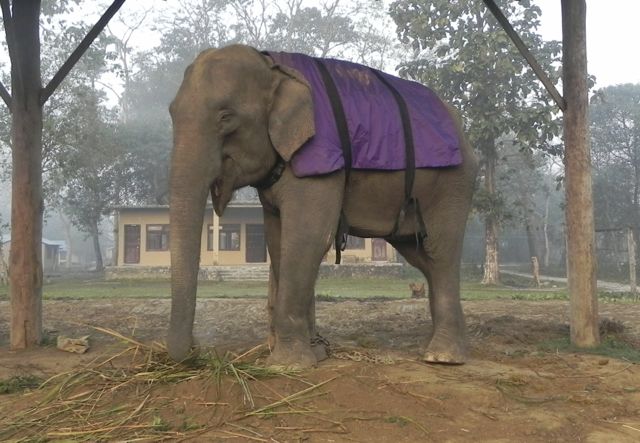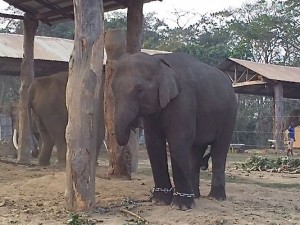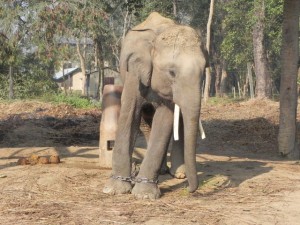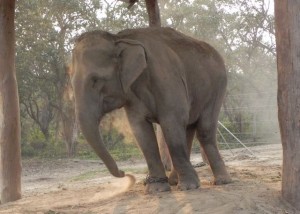Partnering with people and organizations with shared goals is key to success as a foreign NGO working in Asia. Since hurry up and wait is a culturally accepted norm, an ample supply of patience and flexibility is required if you hope to have a successful project.
And even the best-laid plans can unravel without a moment’s notice.
But the daily challenges of different language, conflicting cultures and not having a Home Depot to run to for much needed supplies, is what builds character. Serious determination is required.
When I shift from the U.S. to Nepal, I know to reset my internal clock, tone down my aspirations and prepare myself for unexpected changes to my plans. This may be a breeze for some, but it is a serious challenge for me. But by keeping my eye on the prize—improved elephant welfare—I am able to operate outside my comfort zone and learn a different way of being.
The Next Phase of Chain Free Corral Construction
By the time I stepped off my flight in Kathmandu, the image of my goal was playing in technicolor in my brain, primed for manifesting.
But that is when reality strikes. I recognize that my vision must be shared by my partners for it to become more than a well-thought-out dream.
I am currently working with a fabulous young Australian woman named Chantelle Ridley, whom I hired to organize our Free the Elephant Program volunteers in Nepal.
Chantelle interned with me a year ago and has turned out to be a perfect fit for this job. Her easygoing attitude, combined with excellent people skills and intimate knowledge of Chitwan, has helped make our new volunteer program a smashing success.
Chantelle’s assistance frees me up to concentrate on the bigger picture of our Chain Free Means Pain Free Program work: identifying locations, designing chain-free corrals, managing the fence building crew from India and overseeing the local labor.
Each installation comes with its own unique set of challenges, both situational and logistical.
To ensure a water source for elephant bathing and drinking, most hattisars are built near a river, which means that they flood during monsoon season.
For safety, the mahouts (elephant staff) always want the chain-free corrals to be built directly adjacent to their sleeping quarters. There is the constant threat of an unscheduled appearance of wild rhinos, man-eating tigers and menacing bull elephants in musth.
In some locations, available space is limited or there is sparse tree cover.
Contaminated soil caused by years of stockpiling and burning elephant manure is a universal issue.
With 31 corrals to our credit in 2014, I was overly confident that the next installation would follow the same successful route.
But I was in for a rude awakening. I immediately realized I would be facing my greatest challenge yet.
Both installations scheduled for this year house multiple elephants–ivory carrying males, females and calves. Like humans, elephants are individuals and even though they share common language and needs, they have unique personalities that must be acknowledged in order to improve their lives.
Upon arrival, my first challenge was to discover that the dense forest promised for 15 corrals was no longer available. Instead, it had been set aside for the local people, a decision that is difficult to argue with.
This left me with a dilemma: build corrals for ivory carrying males that I intuitively know are too small, or build nothing at all.
In Nepal decisions are made by unanimous agreement of the entire group involved. If one stockholder does not agree, the project will not move forward. Opinion was split: the mahouts, head veterinarian and an influential NGO wanted to keep the males on chains, while the chief warden and I wanted to make some degree of improvement and meet our goal of getting the bulls off chains.
After a healthy group discussion, we took a walking tour of the facility. Everyone agreed we would build mini-corrals, to see if they would work.
Optimism is my strong suit, definitely what drives me to believe that elephants in captivity can experience a better, more humane existence. I agreed to reduce the size of the chain-free corrals rather than building none at all.
After working diligently for two weeks to create six chain free corrals, the volunteers, fence crew, local labor, mahouts, chief warden and I were present for the unchaining. What a thrill.
But shortly after dark, after the crowd had dispersed and we were patting ourselves on the back, forty-year-old, mild mannered bull Dipendra Prasad effortlessly and silently removed the back gate of his corral and slipped out into the night.
When his escape was discovered, you could hear a collective exhale of disappointment.
This morning the mahouts returned Dipendra Prasad to the hattisar but only after a massive manhunt to bring him back.
Everyone is now in agreement that there is not enough space in this location for chain-free corrals for adult males. My job now is to get back to the drawing board and come up with solutions. Adult males are always the most challenging individuals to care for in captivity.
If we hope to provide a chain-free life for the mature ivory carrying bulls of Nepal, corrals must be spacious, heavy with trees and natural vegetation and away from human populated areas. Most important, they must be constructed of steel pipe!
But our effort at this location, the Sauraha hattisar, is not a total loss. Three acres of densely forested land has been set aside for a chain-free corral for three females and a young male.
The volunteers and fence crew are constructing the corral as we speak. The corral will be completed and the elephants; Loctundra Kali, Oma Kali, Sundar Mala and Paris Gaj, released from their chains within 7 days.




